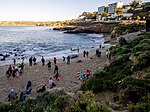Tyrolean Terrace Colony
American Craftsman architectureAmerican Craftsman architecture in CaliforniaBungalow architectureCulture of San DiegoHistoric preservation in the United States ... and 4 more
History of San DiegoLa Jolla, San DiegoNational Register of Historic Places in CaliforniaNational Register of Historic Places in San Diego

The Tyrolean Terrace Colony (1911–1912) was an Arts & Crafts-style hotel bungalow court in La Jolla, San Diego, California, adjacent to the former Green Dragon Colony. It catered to early automobile traffic along Coast Blvd., a scenic drive that led to La Jolla Park and other sites along the shore. The property, but not the buildings, was listed as a San Diego Historical Landmark in 1975 (HRBS 102). The Village Stairway to Goldfish Point and Caves, leading from Prospect St. to Coast Blvd., is located on the former site of the Colony.
Excerpt from the Wikipedia article Tyrolean Terrace Colony (License: CC BY-SA 3.0, Authors, Images).Tyrolean Terrace Colony
Prospect Street, San Diego La Jolla
Geographical coordinates (GPS) Address Nearby Places Show on map
Geographical coordinates (GPS)
| Latitude | Longitude |
|---|---|
| N 32.848888888889 ° | E -117.27055555556 ° |
Address
Prospect Street 1296
92037 San Diego, La Jolla
California, United States
Open on Google Maps









